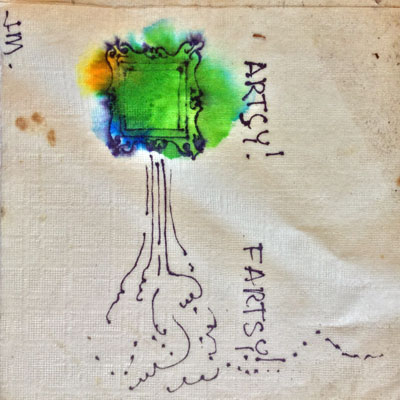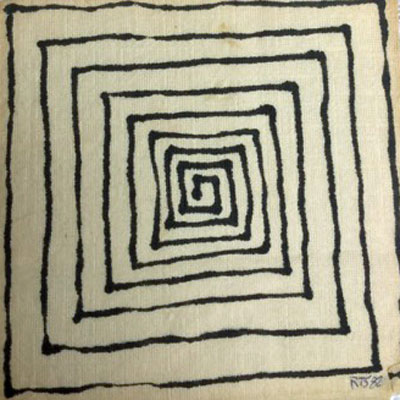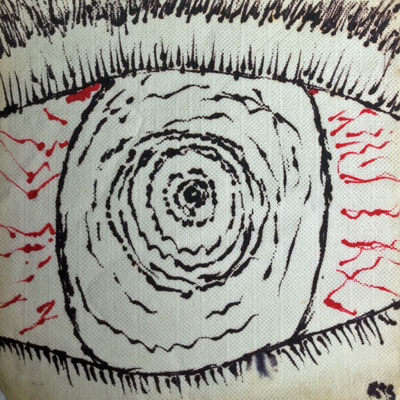[Click on BLUE links for more information]
A few months ago I was climbing down a rickety ladder from a loft in my house with a box of files precariously balanced on one hand, the other hand guiding me down the wobbly rungs of the ladder. My eight-year-old grandson was watching from a safe distance when the box shifted and everything collapsed onto the carpet below while I hung on by a thread to the ladder. I barely avoided a crash that would have catapulted me out the third story window onto the deck below like Humpty Dumpty.
“Think in the morning, splat in the afternoon,” said my grandson spontaneously. He knew about my blog. He knew the name, and he came up with the improvisation on the spot.

Sea Gull Cellar Bar Napkin Art, Roy Hoggard artist
I’ve thought about that often in the months following, sometimes with a laugh, sometimes in a sweat induced by thinking how it could have ended very differently.
Several blogs ago I posted Think in the Morning, It’s Good for You where I listed the Top 10 Advantages of Waking Up Early based on an article in Forbes. I recently communicated with the author of that article, Frank Apodaca. There is an update you can read HERE: 15 Reasons to Rise Early – Benefits of Waking Up Early. (All 15 are listed at the bottom of this post but you should read the entire article for the sources and for many more interesting facts.)
After my Splat in the Afternoon, I felt I needed to reconsider whether or not early risers really are at an advantage. After all, for some getting up early is a difficult chore. It would be good to know if it really is worth it.
By way of disclosure, I am a morning person. I’m usually up at 5 and with my freshly pressed coffee (I’m definitely a coffee snob) in hand, I start the morning with a quick glance at my emails, answering those of importance and deleting those that aren’t. I move on to a quick review of the morning’s news and a look at the financial markets. Since I’m not a trader and am retired from my last day job as a financial advisor, I leave the serious analysis of the markets to others including my friend over at Global Macro Monitor. Specialization has its benefits in this complicated world. All of this takes at most half an hour, usually less.
Recently I’ve been posting a poem every day on my Think in the Morning Facebook page (@ThinkintheMorning) combined with a sample of “napkin art” collected while I was owner/operator of the Sea Gull Restaurant and Cellar Bar. I truly enjoy reading great poetry including interesting articles online about the poets I post. And, the napkin art provides a nostalgic feast taking me back to a wonderful time in my life. I produce nothing new here, just the convenience of reading a poem every day with the art.

Sea Gull Cellar Bar Napkin Art, James Maxwell artist
With my initial chores done, my morning moves on in one of two different directions. [Note: I am recently retired thus not impeded by a day job.] I either read for enjoyment and/or research or I focus on my own writing [this blog or something else I’m working on].
I chose Think in the Morning as my moniker for this blog. “Think in the morning, act in the noon, eat in the evening, sleep in the night” is from William Blake’s Proverbs of Hell. It works for me, but how typical are early risers and does it really matter whether one is a lark or an owl or somewhere in-between?
To find the answers, I consulted my auxiliary hard drive (Google Search), and discovered a mountain of data relevant to the question. After reading several articles, I discovered an amazing book: Daily Rituals: How Artists Work by Mason Currey. Not only that, I found a number of articles online by the same Mason Currey to answer a slew of questions I have about how and why successful people are successful, particularly writers. Don’t turn away in disgust. This is not one of those worthless self-help ideas, not another insidious life-coach program, not an uninspiring inspirational video. No, Currey’s book and the online articles come off as funny, serious, entertaining, and consoling at least to ordinary people like me.

Sea Gull Cellar Bar Napkin Art RTS artist
Here are a few nuggets I gleaned.
It turns out that there is one common eating habit and it is simply not eating very much. Over and over, various artists mention that they work better on an empty stomach or after eating relatively little.
If all of this makes the life of the artist sound awfully repetitive and dull—well, that’s sort of the point. For many artists, deciding what to eat is just one more distraction from the work. If you want to devote hours of intense focus to your art, something else in your life has got to take a backseat, and all too often it is lunch.
Sobriety is a requirement of most artistic work. … Of course, plenty of artists figured out ways to be in total possession of their faculties for a few hours a day and be wasted for much of the remainder.
W. C. Fields: “I’ve often wondered how far I could have gone had I laid off the booze.”
Caffeine is the rare drug that has a powerful salutary effect—it aids focus and attention, wards off sleepiness, and speeds the refresh rate on new ideas—only with minimal drawbacks.
Balzac: “Were it not for coffee one could not write, which is to say one could not live.
Paul Erdos: “A mathematician is a machine for turning coffee into theorems.”
David Lynch: “For seven years I ate at Bob’s Big Boy. I would go at 2:30, after the lunch rush. I age a chocolate shake and four, five, six, seven cups of coffee—with lots of sugar. And there’s lots of sugar in that chocolate shake. It’s a thick shake. In a silver goblet. I would get a rush from all this sugar, and I would get so many ideas! I would write them on these napkins. [napkin art ?] It was like I had a desk with paper. All I had to do was remember to bring my pen, but a waitress would give me one if I remembered to return it at the end of my stay. I got a lot of ideas at Bob’s.”
Marcel Proust, Franz Kafka did great work in the wee hours as did Henri de Toulouse-Lautrec, Samuel Johnson, Gustave Flaubert, Marcel Proust, and George Sand.
Frank Lloyd Wright favored early morning as did Anthony Trollope (and his mother Frances Trollope), Sylvia Plath, Ernest Hemmingway, Toni Morrison and Haruki Murakami.
John Cheever believed sex improved his writing—and his eyesight.
[various online articles HERE]

Sea Gull Cellar Bar Napkin Art, Roy Hoggard artist
And, here is the payoff:
In the introduction to this series, I admitted that imitating the rituals and habits of great artists is not going to make anyone suddenly capable of producing great art. But I do think there is some useful advice to be gleaned from these entries—not just for struggling artists but for anyone trying to get more done each day.
For instance: You should figure out what time of day (or night) you work best, and then carve out a couple hours at that time to do your most important work. While you’re at it, you should probably drink a cup of coffee or tea. A daily walk is also recommended, as is an afternoon nap. And if doing all of this means paring back your social calendar, that is a sacrifice you should be prepared to make. (But if you have to hang on to a day job, don’t despair.)
Before I sign off, there is one more creative strategy that I want to address, although it’s not so much a habit as an attitude. There is a popular notion that artists work from inspiration—that there is some strike or bolt or bubbling up of creative mojo from who knows where, and artists channel this energy, or tap into it, or become the conduit for it.
Maybe there’s some truth to this. But, I hope the Daily Rituals book makes clear that waiting for inspiration to strike is a terrible, terrible plan. In fact, perhaps the single best piece of advice I can offer to anyone trying to do creative work is to ignore inspiration.

Sea Gull Cellar Bar Napkin Art, RTS artist
Okay. The point is there is no magic bullet. Of course you knew that, right? Know thyself, said Socrates. Use that to figure out what works for you. As for me, I’m a morning person like I said. Here are the 15 Reasons to Rise Early – Benefits of Waking Up Early as I promised. If you are a morning person, the list will make you feel good. Be sure to go to the link for more information, facts and sources. If you’re not a morning person, or even if you are, read Mason Currey’s book and you will find lots of ways to skin a cat. If you want to skin a cat, that is. In the meantime, think in the morning but don’t splat in the afternoon.
15 Reasons to Rise Early – Benefits of Waking Up Early
1. Better Grades
2. Positive Outlook
3. Better Problem Solvers
4. More Energy
5. More Organized
6. More Time to Exercise
7. Better, Deeper Rest
8. Less Traffic, Easier Commutes
9. Uninterrupted Time to Work
10. More Family Time
11. Better Mental Health
12. Eat Healthier
13. Serenity
14. Time to Relax
15. First Choice of Breakfast Items at the Coffeehouse


You’re up at 5 AM??? What time do you go to bed, for crying out loud?? And you must be one of these freaks who doesn’t need a lot of sleep. Six or seven hours does it, I’ll bet!
That early-rising stuff is all fine and dandy, but if you’re an industrial-strength insomniac and ALSO someone who needs a solid nine hours of sleep in order to not rise from bed as if rising from the grave, then what??
Sigh…
You would love Daily Rituals, the book. Get it, read it. I’ll refund the money if you don’t like it. As for us, https://m.youtube.com/watch?v=CIYS9EQWkXg
It’s not that I don’t WANT to get up early and enjoy all those virtues/benefits/advantages; it’s that if I did, with anything less than nine hours sleep, I’d be a shambling, wretched, aching, defeated, mentally ill zombie…that list is a taunt!
And everywhere I turn, I see articles like “The Dangers of Not Getting Enough Sleep!” Alzheimer’s, stroke, Parkinson’s, madness…it’s enough to keep a person lying awake at night!
I’ll get that book. One of the editions, according to Amazon, was published in 1900. saw the author’s picture; he looks damned good for a 150-year-old man. Another benefit of getting up early, I’m sure!
We all have our crosses to bear my dear. If it’s the fountain of youth you seek, no worries. Vampires can live forever under the right conditions and they are not morning people.
Dave…being an illustrator I have found that the “inspiration” theory is indeed a concept created by non-artists. It’s all about the work….the mileage…the grind or getting er dun!
Morning is the best time to train…my afternoon and early evenings are best for artwork. The evening is best for kicking up my feet, having a glass of wine, watching TV and hanging out with my kitties….
As they say…plenty of time to sleep after we die…..
Thanks Matt. Given the amazing art you create, your “ritual” is worth noting especially for those of us like myself who always feel scattered. If only I were organized !
Reason #16 for getting up early is to enjoy the “extra” hour of daylight wrested in a California State referendum from us honest hardworking late-nighters and late-risers during the long dark winter.
That makes two in favor of sleeping in. I’ll have to reconsider.